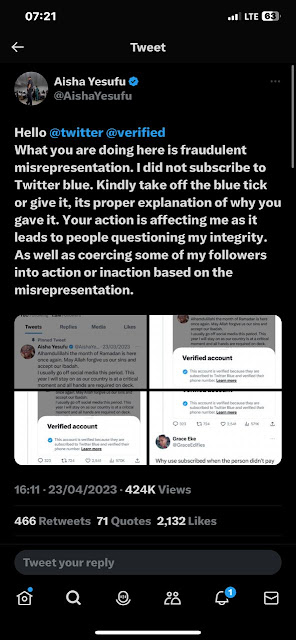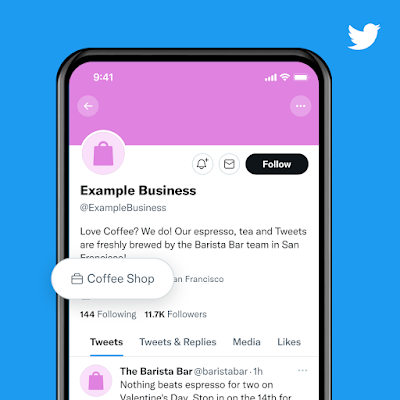Twitter checkmarks and what they symbolise
Upon acquiring the social media platform, THE Chief Executive Officer of Twitter, Elon Musk, announced that the verification checks that serve as a symbol of an account’s authenticity would be a paid subscription.
Initially, Twitter used a “Blue check” verification system with the aim of boosting users’ confidence in the platform by placing a blue check mark next to the names of public figures, companies, journalists, and organisations.
When the subscription was launched, the initial verified accounts were referred to as legacy accounts to differentiate them from those who got the check via the Twitter Blue subscription.
The ICIR had earlier reported that the new Twitter CEO removed blue checks from all the legacy verified accounts that did not subscribe to its new verification system. The development affected many notable individuals and organisations.
In addition to the earlier blue checks, Twitter now has verification badges such as Gold Checkmarks, Company affiliation marks, Official(Grey) checkmarks, and Affiliation badges that symbolise various meanings. In this article, we explain what each of these badges means.
(1) Blue Checkmark
The blue checkmark indicates that an account is subscribed to Twitter Blue and meets Twitter’s eligibility criteria. For accounts that receive the blue checkmark through a Twitter Blue subscription, there is no additional review to verify their adherence to the previous criteria of being active, notable, and authentic.
At a cost of $8 per month on the web (or $11 per month on iOS and Android), eligible accounts can obtain the badge along with additional features such as reduced ads, tweet editing capability, extended tweet length up to 10,000 characters, and text formatting options.
To qualify for eligibility, an account must have been active within the last 30 days, possess a display name, profile photo, and a verified phone number, and not impersonate other accounts or entities.
It appears that accounts with one million or more followers are also receiving the blue checkmark automatically, sometimes even against the explicit wishes of the account owners.
After they removed the check marks from all the legacy verified accounts, they returned it for some of the people with 1 million followers and above. People like Aisha Yesufu called out Twitter several times for verifying them without applying for it.
(2) Gold Checkmark
This checkmark indicates that the account belongs to a company or an organisation. The social network launched the “Blue for Business” plan on December 19, which shows company profile pictures in a square with a gold checkmark.
(3) Official (Grey) checkmark
The checkmark is used primarily for the government, and it’s relevant agencies, departments and ministries.
“Eligible government organisations at the national level may include: Main executive office accounts, agency accounts overseeing specific areas of policy, main embassy and consulate accounts, and parliamentary or equivalent institutional and committee accounts. Eligible government organisations at the state and local level include: Main executive office accounts and main agency accounts overseeing crisis response, public safety, law enforcement, and regulatory issues,” Twitter stated.
“Eligible government individuals may include Heads of state (presidents, monarchs and prime ministers), deputy heads of state (vice presidents, deputy prime ministers), national-level cabinet members or equivalent, the main official spokesperson for the executive branch or equivalent, and individual members of all chambers of the supranational or national congress, parliament, or equivalent.”
(4) Affiliation badges
Affiliation badges indicate that a Twitter account is associated with an organisation. These badges feature the profile photo of a verified organisation and are applied to all affiliated accounts under that organisation.
Depending on the type of account, affiliated accounts can display gold, grey, or blue checkmarks. Affiliation badges are prominently displayed on Twitter profiles, Tweets, timelines, notifications, direct messages (DMs), search results, and various other places across the platform.
(5) Automated account labels
Automated labels offer transparency by enabling you to distinguish between human-operated accounts and automated ones. When an account is labeled as “automated,” it indicates that the content generated by that account is not created by a human.
According to Twitter, these labels are still currently being tested and can be found on account profiles alongside profile names and handles. To find out additional information about automated account labels.
Once an account accepts the invitation to Twitter’s test group, an automated account label will appear on their account profile under their profile name and handle. The label may also appear on their Tweets.
(6) Professional category labels
When converting to a Professional Account on Twitter, individuals have the freedom to choose their professional category labels. It is important to note that Twitter does not dictate or regulate the selection of these labels, and users have the flexibility to modify their professional category as desired, even after the initial selection.









Comments
Post a Comment